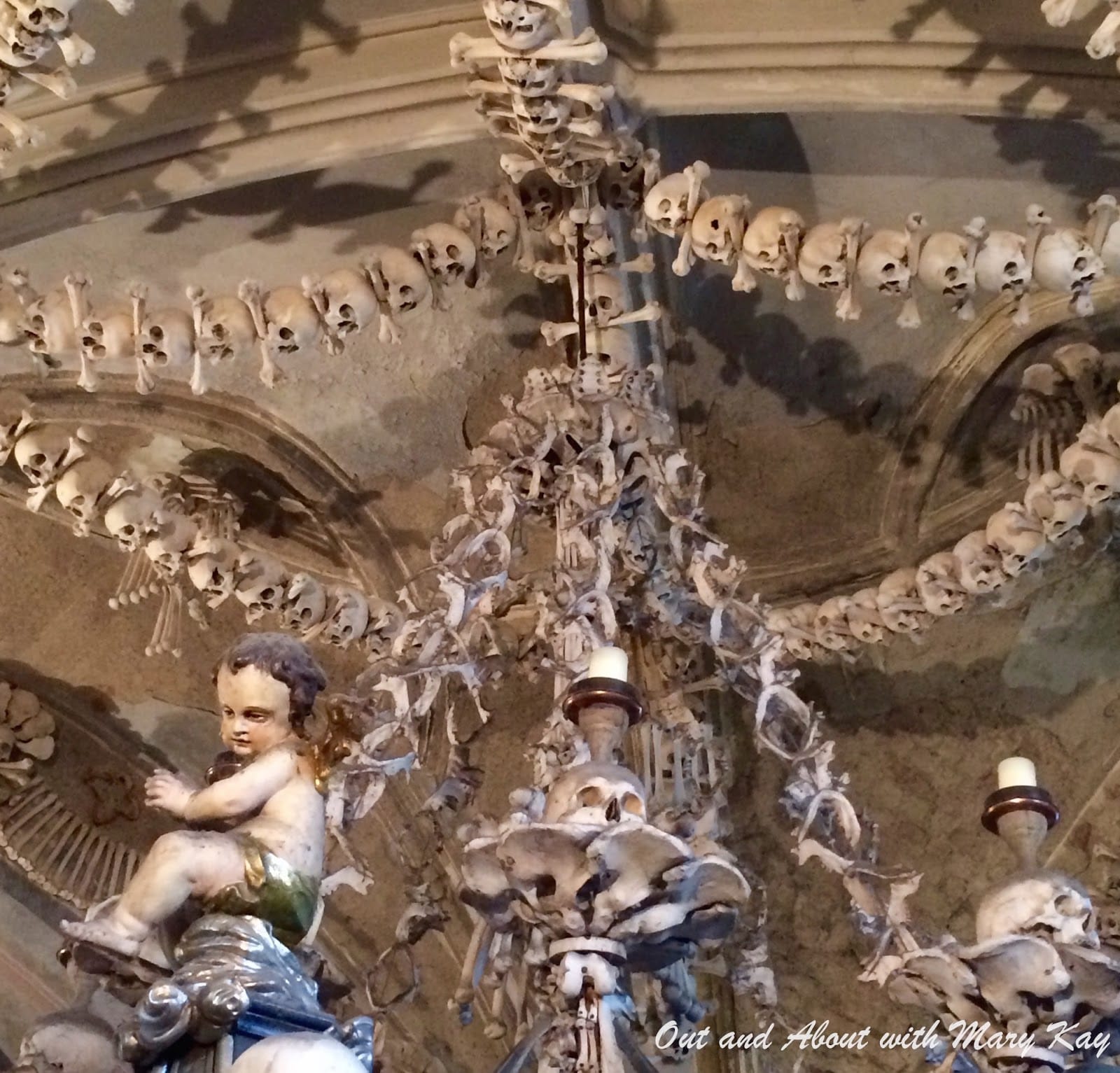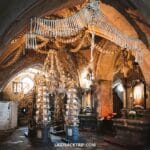Hey there, history buffs, art lovers, and those who ponder the meaning of life! Prepare to delve into the captivating world of the Kutna Hora Bone Chapel, a site where the remains of thousands have been transformed into an evocative and thought-provoking display. From its humble beginnings to its current form, this chapel brims with history, macabre beauty, and profound life lessons.
Where History and Art Intertwine
Nestled in Kutna Hora, a town renowned for its medieval past, lies the truly unique Sedlec Ossuary, more commonly known as the Kutna Hora Bone Chapel. More than just a chapel, it is an ossuary, a final resting place for countless souls, and a poignant testament to the delicate balance between life and death.
Our journey begins in the 13th century, when Abbot Henry returned from a pilgrimage to the Holy Land bearing a unique gift: sacred soil from Golgotha. This soil, believed to possess holy power, was sprinkled on the monastery cemetery, instantly transforming it into a highly sought-after burial ground.
As word spread, the desire to be laid to rest on this sacred ground grew. However, over the centuries, particularly during the Black Death and the Hussite Wars, the cemetery faced a somber challenge: overcrowding.
Enter František Rint, a woodcarver with an extraordinary vision. Tasked with organizing the massive quantity of bones, Rint embarked on a project that went far beyond anyone’s imagination. He didn’t simply organize the bones; he elevated them into art.
Imagine walls and ceilings adorned with human skulls, femurs, and every bone imaginable. A bone chandelier hangs from the ceiling, casting eerie shadows. A coat of arms, crafted entirely of bones, stands as a testament to a wealthy family’s patronage. Garlands of bones, delicate and macabre, are strung throughout the space. It’s both unsettling and captivating, serving as a stark reminder of the impermanence of our physical forms.
Contemplating Our Mortality
The Kutna Hora Bone Chapel is more than a spectacle; it’s a profound experience that compels us to confront our own mortality and the fragility of life. Each bone represents a life lived, a story left untold. It blurs the lines between life and death, art and religion, beauty and decay, creating a space for reflection and introspection.
Here are some particularly striking features:
- The Bone Chandelier: This jaw-dropping masterpiece incorporates every single bone in the human body, a testament to Rint’s meticulous craftsmanship.
- The Schwarzenberg Coat of Arms: This intricate design, commissioned by a wealthy family who were patrons of the chapel, illustrates how deeply art and history can intertwine, even in the most unexpected places.
Rint’s bone art has sparked various interpretations. Some believe it conveys a subtle message about the fleeting nature of earthly possessions. Others view it as a beacon of hope for the afterlife, symbolizing the promise of resurrection. Regardless of your interpretation, one thing remains certain: this place will linger in your thoughts long after you leave.
The Kutna Hora Bone Chapel is a journey into the heart of what it means to be human. It’s a place where art, history, and the mysteries of life and death converge. If your travels ever take you to the Czech Republic, be sure to place this unique and unforgettable destination at the top of your list.
Unlocking the Story: A Deeper Dive into History
Let’s delve further into the captivating history of the Kutna Hora Bone Chapel. The story begins around the 13th century, when Abbot Henry of Sedlec returned from a pilgrimage to Jerusalem. His journey yielded an unusual souvenir: soil from Golgotha, a site believed to hold immense spiritual significance. This act transformed the monastery cemetery into a coveted burial ground.
Centuries later, the Black Death swept across Europe, leaving devastation in its wake. Wars further contributed to a surge in mortality, pushing the monastery cemetery beyond its capacity. To accommodate the deceased, a new Gothic church, now known as the Cemetery Church of All Saints, was constructed. Beneath this church, a subterranean ossuary was created to house the remains from the overflowing graveyard.
Over time, the ossuary became the final resting place for an estimated 40,000 to 70,000 individuals.
In 1511, a monk with failing eyesight was tasked with the daunting yet sacred duty of exhuming and organizing the mountains of bones within the ossuary. This act, though seemingly macabre, reflects a deep reverence for the deceased. Centuries later, in the early 18th century, architect Jan Santini Aichel further shaped the ossuary, incorporating elements of Baroque design.
The ossuary’s most dramatic transformation occurred in the 1870s, when František Rint, a skilled woodcarver, was commissioned by the wealthy Schwarzenberg family to create something extraordinary. Rint, using the bones themselves as his medium, fashioned intricate arrangements, including the iconic bone chandelier, the Schwarzenberg family crest, and even his own signature, forever etched in bone.
In the 20th century, Czech filmmaker Jan Švankmajer brought the ossuary’s story to the screen with his short film documenting its history and Rint’s remarkable contributions. Today, the Sedlec Ossuary within the Kutna Hora Bone Chapel is recognized as a UNESCO World Heritage Site, attracting visitors from around the globe who are drawn to its unique blend of history, art, and spirituality.
Are the Bones Real?
The question often arises: are the bones in the Sedlec Ossuary authentic?
The answer is a resounding yes. These are the real remains of individuals laid to rest in the church cemetery between the 14th and 16th centuries. The ossuary’s existence is a testament to the challenges of managing space for the deceased, particularly during times of widespread mortality.
František Rint’s artistic intervention, while seemingly unusual, transformed the ossuary from a simple repository of bones into a space of contemplation and reflection. The Sedlec Ossuary reminds us of life’s fragility and the inevitability of death, encouraging us to ponder our own mortality and the legacy we will leave behind.
How Old is the Sedlec Ossuary?
While the exact date of the Sedlec Ossuary’s construction remains a subject of debate among historians, most agree that its origins likely date back to the 15th century, around the year 1400. Several factors support this estimate:
- The Black Death: This devastating pandemic, which ravaged Europe in the mid-14th century, led to mass burials and a pressing need for additional space to inter the deceased. It’s highly probable that the ossuary was constructed in response to this crisis.
- Gothic Architecture: The chapel’s architecture exhibits characteristics of the Gothic style, prevalent in Europe during the 14th and 15th centuries. This suggests that the chapel, which houses the ossuary, was likely built during this period.
While the ossuary has undergone renovations and artistic additions throughout the centuries, the core structure likely remains largely unchanged from its original 15th-century form.
The Sedlec Ossuary, with its long and layered history, encapsulates centuries of change and adaptation. It prompts us to consider our relationship with death and the passage of time, making it a truly remarkable destination.
Beyond the Surface: Exploring Further
To enhance your understanding of the Kutna Hora Bone Chapel (Sedlec Ossuary), consider these additional points:
- Symbolism: Delve into the deeper meaning behind Rint’s bone arrangements. Do they represent a purely decorative choice, or do they embody religious beliefs and cultural attitudes towards death prevalent during his time?
- Ethical Considerations: Engage with the ethical debate surrounding the display of human remains. Explore how different cultures perceive this practice and how the ossuary’s management has addressed potential sensitivities.
- The Schwarzenberg Family: Investigate the role of the Schwarzenberg family as patrons of the ossuary. What motivated their involvement? How did their influence shape the ossuary’s development?
- Artistic and Literary Depictions: Research whether and how the Sedlec Ossuary has been portrayed in other creative works, such as paintings, novels, or films, beyond Jan Švankmajer’s film.
Don’t miss the opportunity to explore other captivating destinations in the region:
- Hraunfossar Waterfall: Immerse yourself in the ethereal beauty of Hraunfossar Waterfall, where crystal-clear waters cascade over ancient lava fields.
- JBS Grand Island, NE: Venture to JBS Grand Island, NE, a vibrant city steeped in history and filled with charming attractions.
- Unlock Water’s Symbolism: A Cross-Cultural Exploration - April 20, 2025
- Identify Black and White Snakes: Venomous or Harmless? - April 20, 2025
- Unlocking Potential: Origins High School’s NYC Story - April 20, 2025















